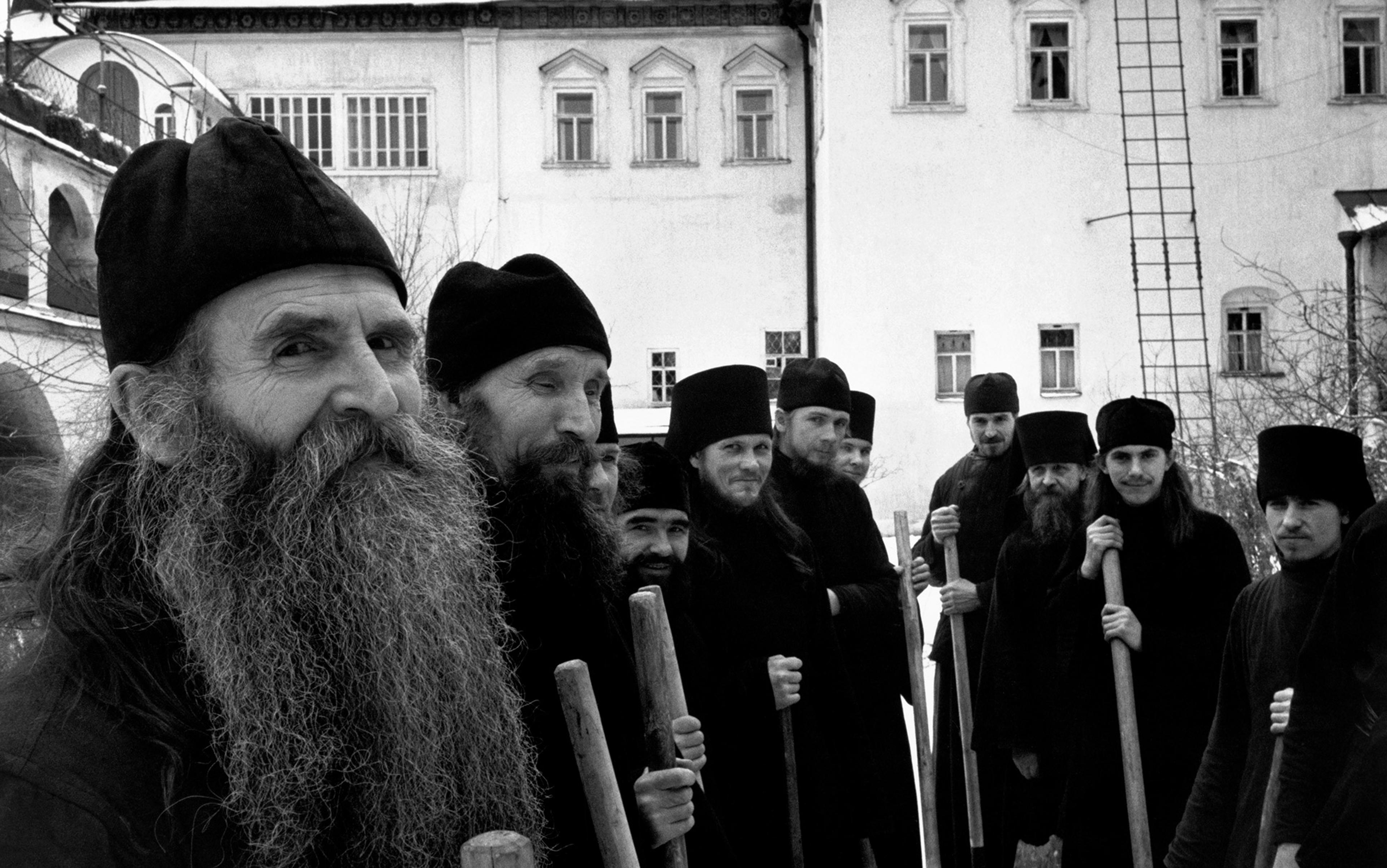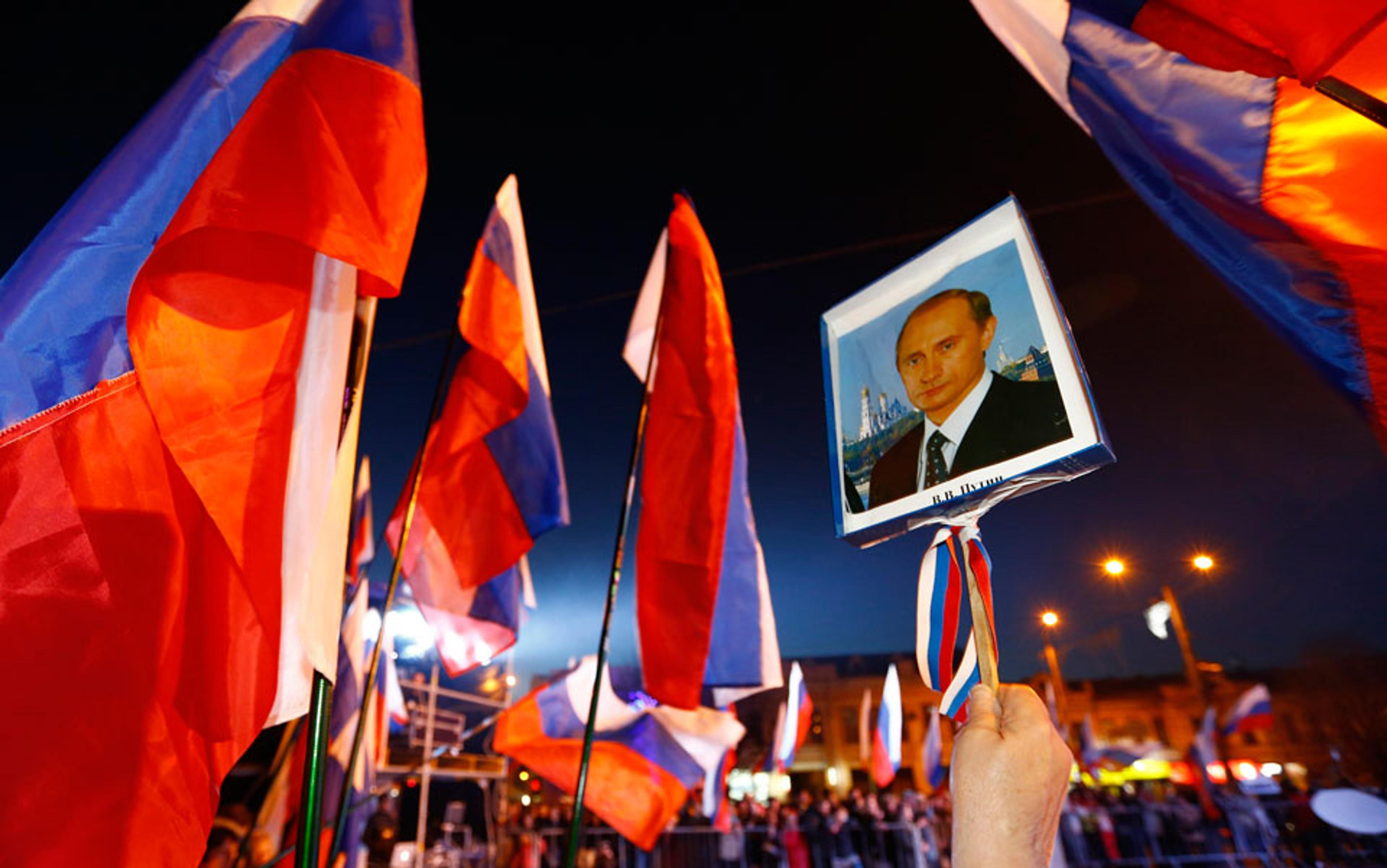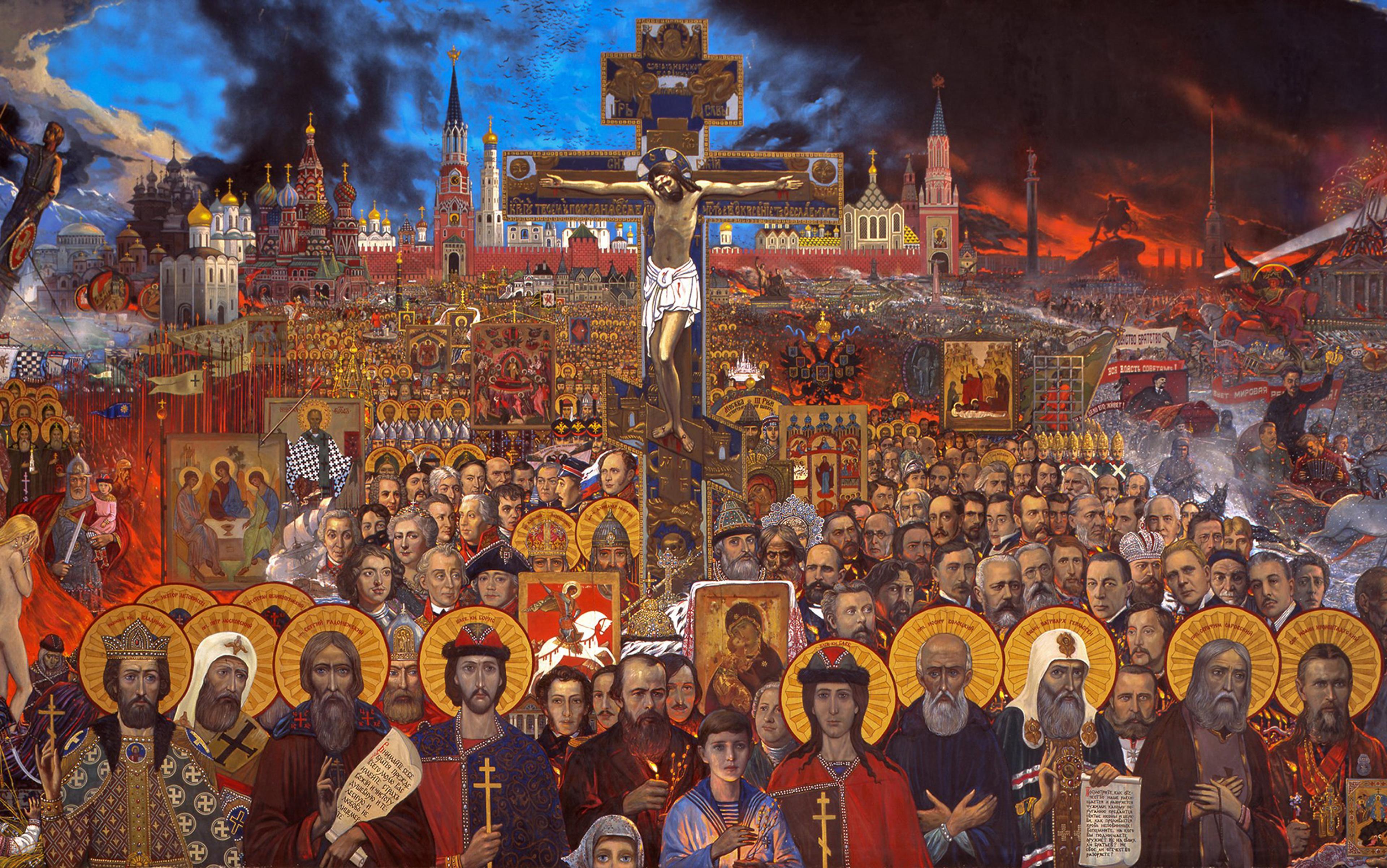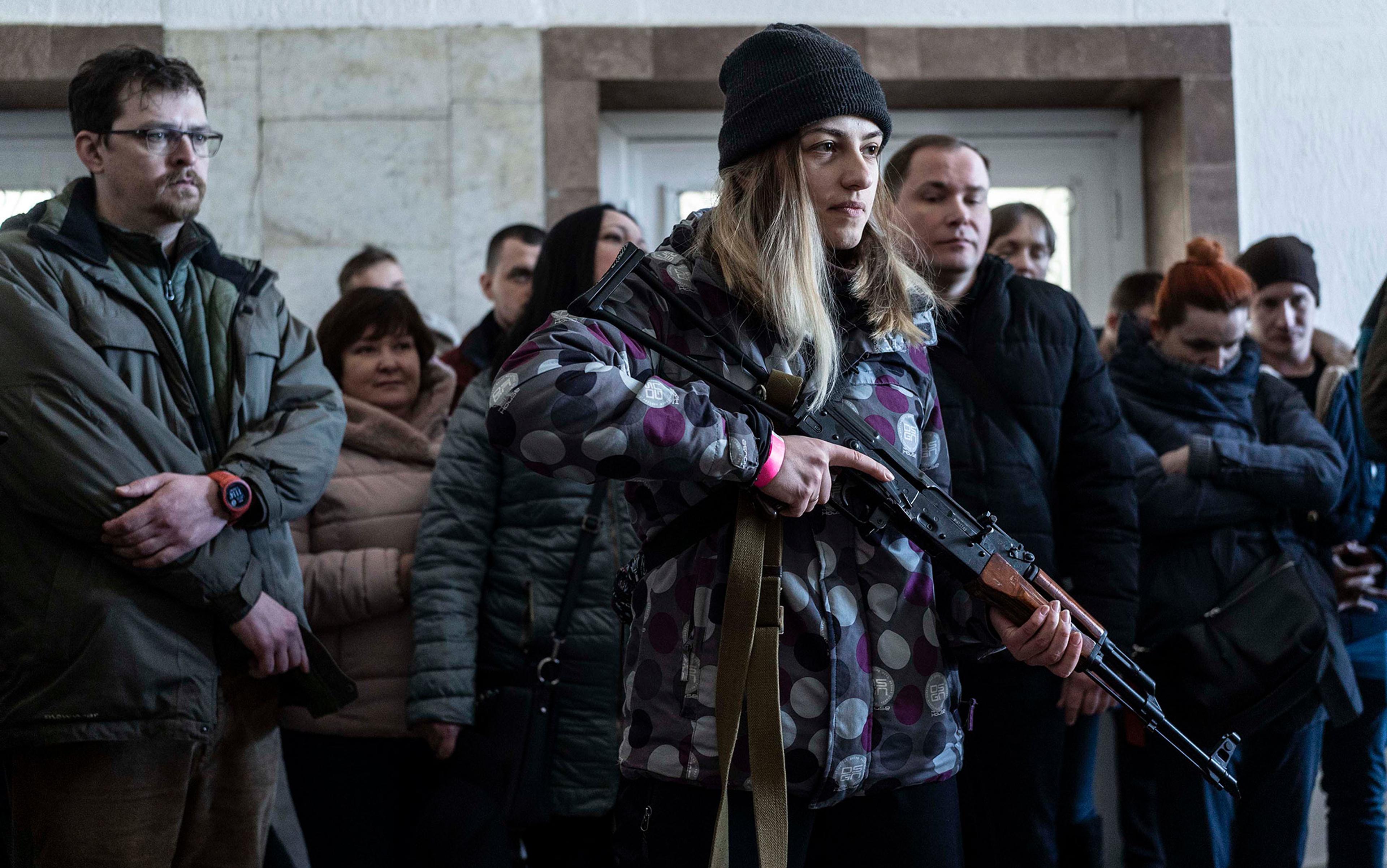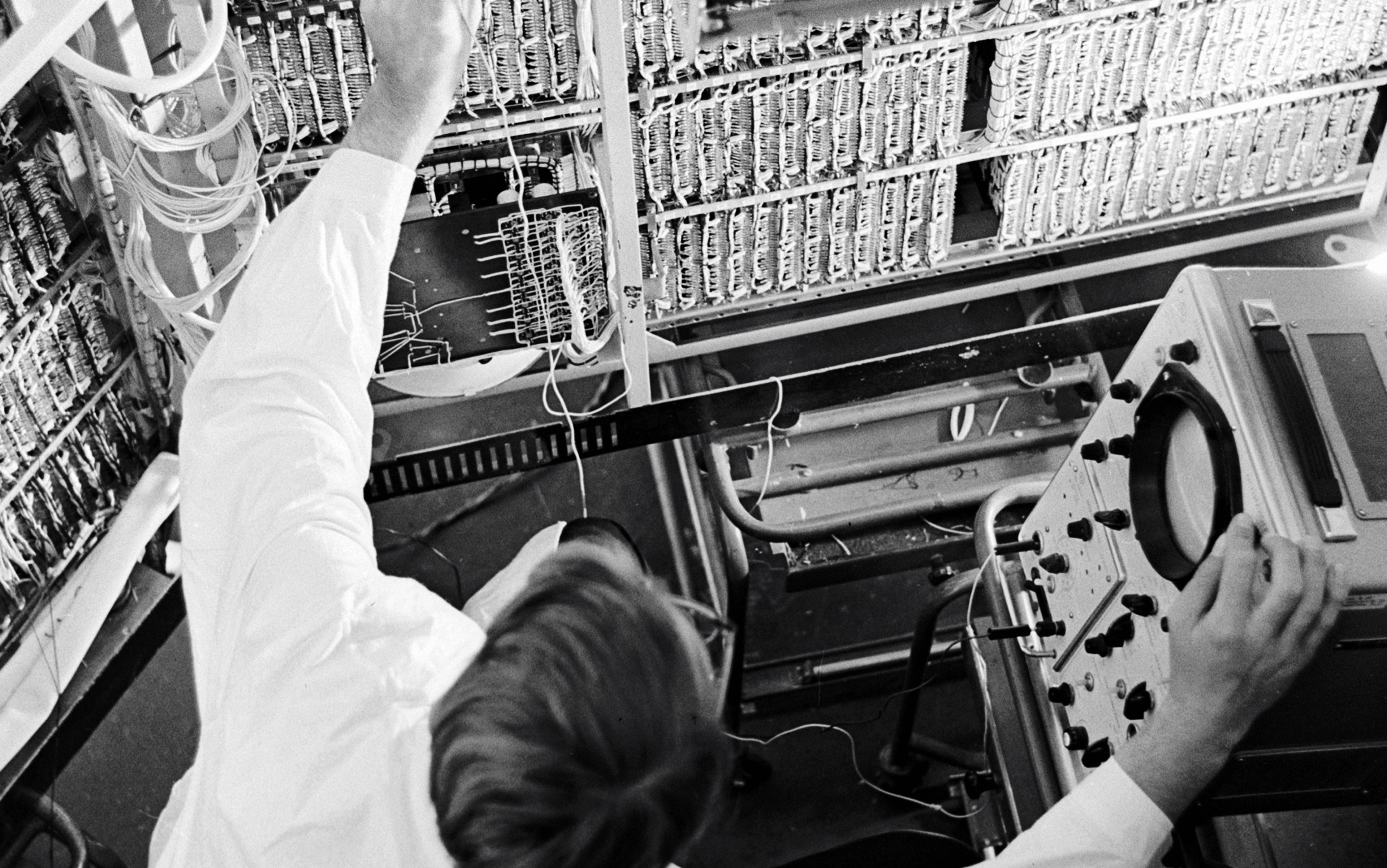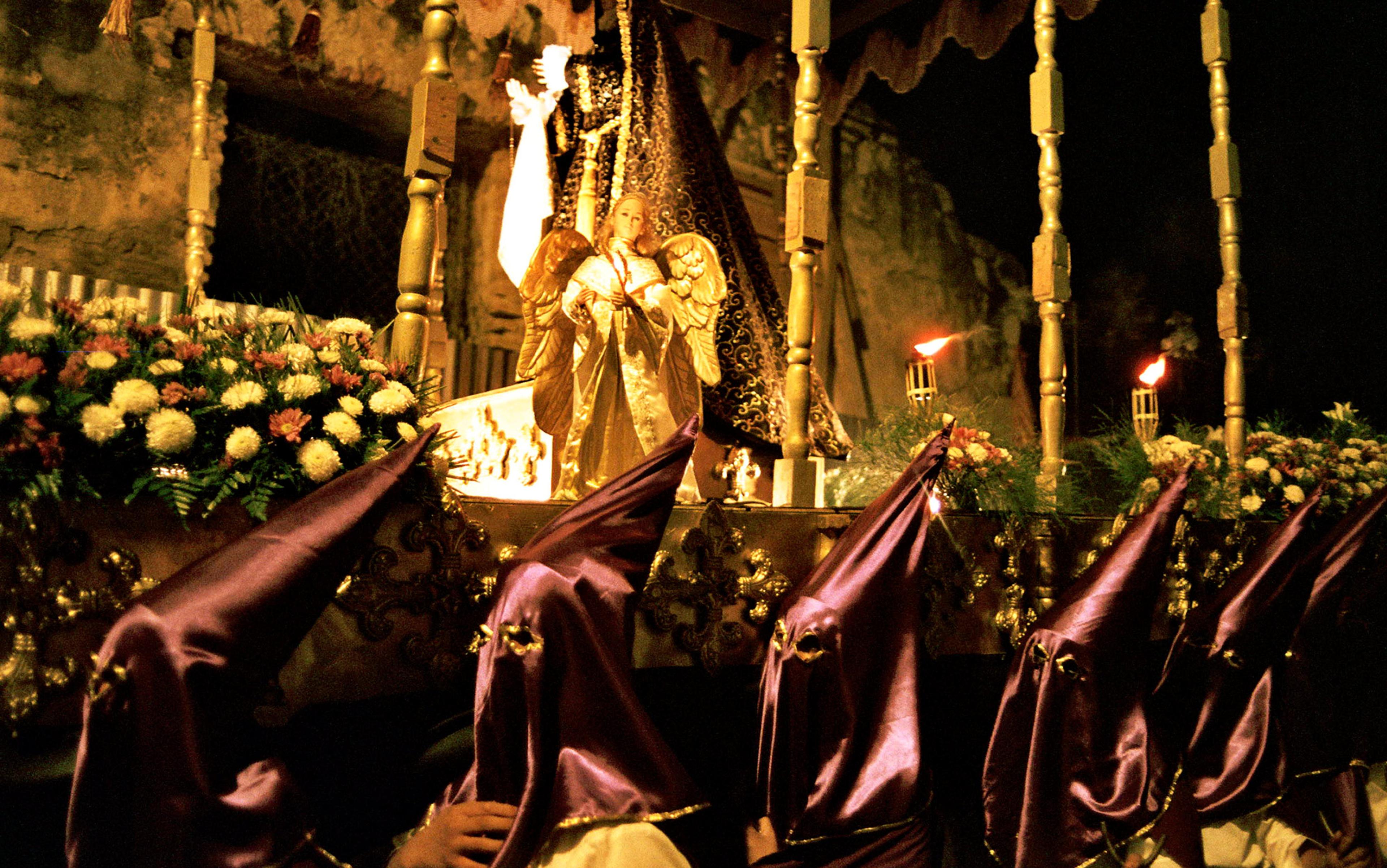In September 1943, as the tide of the Second World War was turning in the Soviet Union’s favour, the Soviet leader Joseph Stalin called a meeting at the Kremlin. Alongside the foreign minister Vyacheslav Molotov and the head of the secret police Vsevolod Merkulov were three men in Stalin’s office for the first time: Metropolitan Sergius, Metropolitan Aleksey, and Metropolitan Nikolay, three of the few Orthodox Church hierarchs left in the Soviet Union.
The fact of such a meeting taking place is naturally surprising. Even those who know little about the Soviet Union are familiar with its anti-religious policies, especially thanks to Cold War rhetoric about ‘godless communists’. Indeed, this meeting was being held after decades of persecution of the Russian Orthodox Church by the officially atheist Soviet state. The three Metropolitans came to this meeting after decades of watching their Church decimated all around them. As they greeted Stalin at the Kremlin, many of their fellow clergy were imprisoned in labour camps – and others were dead. By the end of the 1930s, the Soviet state had effectively destroyed much of the official existence of what had been for centuries imperial Russia’s most powerful and wealthy religious institution.
But in September 1943, as Stalin imagined a role for a victorious Soviet Union in a postwar world, he began to reconsider his government’s position with regards to the Russian Orthodox Church, and eventually to the entire question of the role of religion in an atheist empire. At this meeting, Stalin presented these men with a bold proposal: the same Soviet state that had destroyed their Church was now going to devote its resources to bringing it back.
The story of this meeting and the proposal to revive Orthodoxy is rarely told – but, when it is mentioned, it is dismissed as a wartime measure, as temporary as the friendship campaigns between the USSR and the United States that also characterised the war years. Yet to gloss over this meeting is to miss its significance as a shift in the Soviet approach to religion, one that would leave a mark on religious life for Soviet people and their descendants in the decades that followed.
What was the nature of this shift? It began with an acknowledgement that, despite the state’s efforts, religious ties and ideas of religious belonging resonated with its population. Instead of ignoring the continued influence of religion, the state might be able to use it to its own advantage. Rather than allow religious life to operate outside of Soviet society in the depths of the underground, the state could create an official religious life that could be surveilled, regulated, taxed and, most critically, used to accomplish political goals.
This story does not change the importance of atheism to the Soviet project or the significance of the USSR’s founding as the world’s first atheist state. The anti-religious policies of the Bolsheviks came from both their interpretations of Marxism, as well as the particular Church-state relationship(s) that characterised imperial Russia. On the whole, any religion was seen as a barrier to the transformation the Bolshevik revolution envisioned because it offered a competing authority to the wisdom of the Party leaders who were leading the revolution. But in both the first anti-religious campaigns undertaken by the Bolsheviks as well as the more systematic and large-scale measures of the 1930s, Russian Orthodoxy was singled out because of its close ties to the old regime and its role as partner to the Russian autocracy. Russian Orthodoxy was dangerous in the eyes of the Bolsheviks not just because of its belief system, but also its institutional wealth and influence throughout Russian society.
Stalin’s new approach to Russian Orthodoxy was thus likely possible only because of previous anti-religious campaigns against the Church. State-enforced atheism and its official exceptions were two sides of the same coin. As Stalin saw it, in the tumultuous decades between the Bolshevik revolution in 1917 and the outbreak of the Second World War in 1939, the Soviet project had been transformative enough that religious life no longer posed a threat. In the minds of the architects of the new religious policy, the state was powerful enough to not only control religious life but make it work for its own ends.
Historical spiritual ties could be used to support Soviet claims on eastern European territories
The 1943 meeting led to a series of measures that created a new institutional framework for the Russian Orthodox Church to operate in the USSR. These measures included re-establishing the Moscow Patriarchate, the official seat of the Russian Orthodox Church, and enthroning a Patriarch. Sacred properties expropriated by the state could once again be used by the Church. Seminaries were founded and clergy recruited to teach at them. But ultimate control over Church affairs and ownership of Church property remained with the state. A new bureau was founded for the state administration of the Church: the Council for the Affairs of the Russian Orthodox Church.
What goals was Stalin hoping to accomplish with these initial measures? Insight into the answer to this question can be found in the questions Stalin began posing to state experts on religious life in advance of the meeting, questions that focused on the status of Orthodoxy in eastern Europe. It is no coincidence that Stalin was asking these questions at the moment the tide of war was turning. It was becoming clear to the Soviets that victory in the war could allow them to secure a sphere of influence in eastern Europe. With an officially sanctioned Russian Orthodox Church in Moscow, historical spiritual ties could be used to support Soviet claims on eastern European territories and be used as vectors of political and cultural influence in places with Orthodox traditions, including eastern Poland, Romania, Bulgaria and Yugoslavia. This line of thinking helps underscore how Soviet views on religion had changed in just a short amount of time. The ties between religious communities that had the potential to transcend borders was originally perceived as a threat to the Soviet regime – now it was seen as something the government could use.
There were also other considerations. The Soviets were facing criticism by their wartime allies about the USSR’s lack of religious freedom. The Red Army was also re-taking territory that had been occupied by the Nazis, and understood that the German occupying authorities had, as part of their own strategy, re-opened shuttered churches and mosques on Soviet soil. The Red Army was not so certain that they should be in the business of closing those again. But, in creating a space for an officially sanctioned Russian Orthodox Church, the state was doing more than addressing these immediate concerns – it was looking to a postwar future.
In evaluating the potential for what a state partnership with Russian Orthodoxy could do for Soviet power, Ukraine served as a testing ground, specifically the western region of Ukraine annexed from Poland to become part of the USSR during the Second World War. It is in the Soviet experience with these lands and its peoples that one can find the roots of the wartime shift in religion that culminated in the 1943 meeting.
In 1939, following the secret protocols of the Nazi-Soviet pact, the Soviet Union annexed eastern Poland and divided former Polish lands between Soviet Belarus and Soviet Ukraine. The people living in these lands were mobilised into Soviet society under the banner of what the historian Jan T Gross has called a ‘revolution from abroad’. The Soviets also mobilised the rhetoric of national liberation: calling their annexation of eastern Poland a ‘reunification’, arguing that they were reuniting historically Ukrainian and Belarusian people to historically Ukrainian and Belarusian lands – and, most importantly, under the leadership of Moscow.
Yet behind this rhetoric of ‘reunification’ was a recognition by the Soviet state that these people were quite different from their ‘Slavic brothers’ to the East. At times, this recognition was acknowledged and emphasised. Soviet propaganda materials portrayed these peoples as being different because they had been oppressed by the previous Polish regime and that soon these differences would fade away once they had been transformed by Sovietisation. But Soviet authorities were also worried about the influence of newly Soviet peoples on their Soviet ‘brothers’, especially in Ukraine. Moscow’s perception of Ukraine as disloyal preceded the 1939 annexation – it was a suspicion that led to harsher repressions against those accused of Ukrainian nationalism than of Russian nationalism, for example. But with the new lands added to Ukraine, the threat was deemed starker. Thus, in western Ukraine beginning in 1939, Soviet authorities confronted their worries about subversive Ukrainian political activity with the violent tactics that were hallmarks of Stalinism: mass surveillance, arrests, deportations and executions. The nature of this suspicion has been summed up in the saying: ‘When they cut fingernails in Moscow, they cut fingers in Kyiv, and chop off the entire hand in L’viv.’
But, paradoxically, the singling out of L’viv and its west-Ukrainian surroundings as particularly dangerous could also lead to concessions, not just violent crackdowns. Observing the religiousness of its newly Soviet population in western Ukraine, Soviet authorities feared the potential for religious institutions to mobilise anti-Soviet sentiment in the population. Recognising that the Soviet state did not have the capacity to fully repress religious life in western Ukraine, they began to explore how to use religion for their own ends. Soviet authorities found that religious institutions could be useful partners in supporting the idea of ‘reunification’ as a justification for territorial annexation.
State control of Orthodoxy straddled the blurred boundaries between foreign and domestic policy
At the root of the ‘reunification’ narrative was the idea that these formerly Polish lands were historically Ukrainian and historically tied to Russia. While the Soviets did not initially acknowledge this, this narrative depended on the historical role of a shared religious tradition, specifically Eastern Orthodoxy, in forming and sustaining these ties. Soon, however, the Soviets realised that a pragmatic approach to religion could allow them to buttress their claims to western Ukraine. The idea that these lands on the western borderlands ought to be ruled by Russia could be justified with the presence of Orthodox churches.
Thus, beginning in 1939, the Soviet state began the process of formally transferring churches in this region to Moscow’s spiritual jurisdiction and re-opening them with Russian Orthodox priests. The perceived successes that came out of this 1939 experiment in the western borderlands laid the groundwork for the Soviet-wide revival of the Russian Orthodox Church that began in 1943. In the newly Soviet western borderlands, state control of Orthodoxy straddled the blurred boundaries between foreign and domestic policy, using religion to bring borderland peoples in, as well as extending Soviet influence outside, its own borders. In a letter from the newly appointed head of the Committee for the Affairs of the Russian Orthodox Church, Georgii Karpov explained as much to Nikita Khrushchev, then head of the Ukrainian Communist Party:
We have determined that the Russian Orthodox Church can and should play a role … in Ukraine, in Belarus, in Lithuania, in Latvia, and abroad.
Creating an official, recognised Russian Orthodox Church provided a blueprint for other religious groups in the USSR during the Second World War, often with the same goals in mind. Shortly after creating the Council for the Affairs of the Russian Orthodox Church, Stalin created the Council for the Affairs of Religious Cults to oversee newly revived religious institutions for other religious traditions, including Islam and Judaism.
Not all religions were granted the chance for a regulatory model. Certain faiths were deemed too dangerous to the Soviet order to be permitted an official structure within the Soviet Union, leaving few options for believers and clergy associated with these communities. Still, these groups were not wiped out – instead they managed to navigate a precarious existence on the margins of Soviet society.
The decision to refuse certain religious groups the chance for state recognition, while granting the opportunity to others, gets at one of the central questions raised by the wartime shift in religious policy: could something as complex as religious life be institutionalised, regulated and surveilled to the degree that it could exist to serve the Soviet order? Or, put simply, was Stalin’s Soviet state as powerful as it thought it was?
Over time, the answer appeared to be no. Reports from the officials overseeing religious life are filled with evidence that the experiments with religion were going awry: believers rejecting the authority of ‘official’ clergy in favour of those deemed enemies of the state operating in the underground, religious practices deemed ‘anti-Soviet’ nevertheless occurring in official sacred spaces, historical churches restored by the state to hold services being avoided in favour of basements, woods and rivers where believers felt their surroundings to be more sacred, and reports of Soviet-approved clergy using their platforms to denigrate their government.
The reports show us that, while the Soviet state was not asserting the full control over religion it wished to, they were changing it. In these reports, bureaucrats are parsing out the details of sanctioned religious life and making determinations about what was acceptable in the atheist Soviet Union. Whether believers or clergy chose to engage with Soviet-sanctioned religious institutions or not, they too were making determinations about how their own ideas of the sacred did or did not match up with what official religious life allowed. Underground religious life and official religious life began to develop in conversation with the other. The lines between the two were not always as fixed as believers or the state wanted them to be.
Those who refused transfer from the Greek Catholic Church faced arrest, deportation and death in the gulag
One particularly ambitious experiment with religion undertaken by the Soviet state in western Ukraine helps illustrate these points. When the Soviet state began sending Orthodox clergy to annexed Polish territories in 1939 to enforce their narrative of ‘reunification’, they had to confront the fact that not all of this region’s Slavic population were Orthodox. In much of western Ukraine, they were Catholic. In the city of L’viv and its surrounding region (historically known as Galicia), the majority of Ukrainians were affiliated with the Greek Catholic Church, a Church that practised Eastern-rite Christianity similar to Orthodoxy but that recognised the authority of the Pope and remained under the jurisdiction of the Vatican. The Greek Catholic Church’s presence in this region, dating back to the 16th century, called into question the idea that all being annexed to the Soviet empire had once been unified under one Orthodox civilisation. Historically, members of the Greek Catholic Church often used the existence of their Church to show that Ukraine had a history separate from Russia. Indeed, Greek Catholic clergy and Greek Catholic believers were some of the most important figures in the growth of Ukrainian nationalism.
And so, in western Ukraine, the Soviets did not just establish an official Russian Orthodox Church but also arranged a forced religious transfer from the Greek Catholic Church to the Russian Orthodox Church for the Church’s 3 million believers and hundreds of clergy. Those who refused faced arrest, deportation and death in the gulag. Many who agreed to the transfer did so under incredible duress, including physical torture and threats against their families. Some who refused went into hiding and tried to preserve the Greek Catholic Church in the underground.
The decision to oversee this mass religious transfer from one Church to another was a particularly extreme manifestation of what the Soviet state hoped to accomplish with official religion. In this case, it was not about a state-managed infrastructure for religion, but a direct intervention into the confessional belonging of individual believers to assign them to a religious institution that was more in line with Soviet state goals. To be sure, there was an important historical precedent to this transfer. The Greek Catholic Church itself was established as a way to bring Orthodox believers into the Catholic world in the 16th century. Beginning in the 19th century, Orthodox activists – with backing from what was then imperial Russia – arranged forced transfers of Greek Catholics to the Russian Orthodox Church in the name of ‘restoring’ Orthodoxy to these peoples and lands.
In this way, the Soviet approach to the Greek Catholic Church was informed by the goals and strategies of its predecessor, imperial Russia. Indeed, as much as the Soviet Union put itself forward as a radical break from the old regime, in trying to make sense of its diverse religious landscape, Soviet officials drew on what the scholars Jane Burbank and Fred Cooper define as an ‘an imperial repertoire’, what leaders imagined was possible based on the past practices and constraints of their imperial ancestor. For imperial Russian officials, as well as Soviet ones, forcing a religious transfer from one Church to another allowed religious life to justify conquest with a narrative of national reunification and territorial restoration.
As the head of the local Communist Party in L’viv in Ukraine explained in his report to his superiors about the status of the forced religious transfer:
Reunification should not be carried out in only a formal fashion, but in a way so reunified priests show their devotion to Orthodoxy and inculcate the believer part of the population with love for their fellow Orthodox – Russians, Ukrainians, and other peoples of the Soviet Union.
Outside of western Ukraine in the decades following the Second World War, the realisation that the instrumentalisation of religion was not working led to a reversal of the tolerant wartime policies. In Stalin’s later years and under the leadership of his successor, Khrushchev, many of the reopened sacred spaces were shuttered again. The Council for the Affairs of the Russian Orthodox Church and the Council for the Affairs of Religious Cults found that their requests for funding and personnel were routinely denied. Official clergy came under suspicion, their loyalty to the Soviet state called into doubt. Khrushchev launched renewed campaigns to promote atheism.
But in some places the experiment continued on. In western Ukraine, the Russian Orthodox Church justified its presence as a bulwark against the underground Greek Catholic Church and the associations with anti-Soviet Ukrainian nationalism that came with it. While churches closed across the USSR, Russian Orthodox priests in western Ukraine successfully petitioned for theirs to stay open. By the time the Soviet Union collapsed, 20 per cent of its surviving Russian Orthodox Churches were located in the Galician region of western Ukraine – the epicentre of the religious transfer and a place that had been mostly Catholic before the arrival of Soviet power. The example of western Ukraine demonstrates that, in places where official religion was seen as playing the role the Soviet state wanted it to play, official religion survived – long into the postwar era.
Reflecting on the legacy of this intervention into religious life, it is easy to dismiss the state-formulated Russian Orthodox Church in western Ukraine and other forms of official religious life as purely an imposition. But this ignores the experience of those who found meaning in the official Russian Orthodox Church, who prayed in its chapels, who took Communion from its priests, and who attended the Divine Liturgy – whether reluctantly or not. In trying to instrumentalise religion, in western Ukraine the Soviet state changed how religious institutions were viewed by believers and non-believers alike. The mere presence of an official Russian Orthodox Church associated with the Soviet state created associations between Soviet belonging, Russian imperialism and Ukrainian nationalism that shaped the experiences of believers then, and continue to shape perceptions of religious institutions in today’s Ukraine.
Bohdan felt that he was able to preserve religious life, even under less-than-ideal conditions
Evidence of this impact can be found in the recollections of those who experienced it. A series of oral histories conducted in the early 1990s by what is now Ukraine’s Institute of Church History reflect the nuances of the imposition of Orthodoxy. In an interview in 1993, Bohdan, a Greek Catholic priest who was forced by the authorities to join the Orthodox Church, reflects on his decision to join the official church, noting:
I knew what the Bolshevik authorities [were capable of] … all the churches could be closed … History will say, will judge whether what we did was right or not right. But there was one goal: to protect the faith and protect the Church.
Reflecting on his time as an ‘official’ priest, Bohdan felt that he was able to preserve religious life, even under less-than-ideal conditions. Another person interviewed in the series, Anna, makes a similar justification for her decision to attend a church that was nominally Russian Orthodox, yet explained that, when she prayed, she noted in her prayers that she was still a Greek Catholic:
I went to the [Russian Orthodox church] … I said ‘God … I did not convert. I am praying exactly the way my mother taught me.
The space of official religious life allowed people like Anna to carve out a spiritual existence under official atheism – an opportunity not available in other times and places in Soviet history, but in ways the Soviets likely did not anticipate.
Both Anna and Bohdan began openly attending Greek Catholic churches when the Soviet Union collapsed and it was safe and legal to do so. For them and others interviewed, the state’s association with Orthodoxy meant that Orthodoxy would become associated with Moscow’s imperialist goals for Ukraine. Another woman interviewed, Nina, mentioned that, before the Soviet occupation, she had no negative feelings toward Orthodoxy but now it will be forever associated with ‘Bolshevism’.
But other former Greek Catholics continued to attend Orthodox churches in the 1990s, feeling a connection to the sacred space and the priest associated with the parish during Soviet times, even as an era of religious freedom was ushered in. It is no coincidence that it was these Orthodox communities that became instrumental in the movement for an autocephalous (independent) Ukrainian Orthodox Church. While they found resonance in the Orthodox churches established by the Soviet state, their experience with official religion meant that they did not want the Orthodox Church to continue to serve the goals of Moscow.
There is another critical legacy of the Soviet experiment with official religion that lives on. Many of the men who serve as hierarchs in some of the most important religious institutions in the former Soviet Union received their theological education and clerical training in the strange world of Soviet official religion. They attended Soviet-sanctioned seminaries and led liturgies in state-owned sacred properties. For example, Patriarch Kirill, the head of the Russian Orthodox Church today, attended a Soviet-approved seminary in Leningrad and was selected by Soviet authorities to represent the USSR to the World Council of Churches as the representative from the Moscow Patriarchate, a position he held from the early 1970s into the ’90s.
Often when observers bring up this information, it elicits a great deal of hand-wringing and condemnation over the ties between official religion and the KGB. As these men preside over ceremonies to commemorate the sacrifices of Soviet martyrs, could it be the case that they were the ones responsible for informing on them? It is clear that the tale of official religion is more complex than that. Memoirs and oral histories of those involved in official religion have described their relationship with Soviet officialdom, including the secret police, as a negotiation between what needed to be sacrificed to maintain a legalised existence, and what lines they would not cross in order to maintain their faith and dignity. In this way, the official clergy resembled many other Soviet people faced with a series of impossible choices.
Religious life did not just exist on the margins of the Soviet Union or in the homes of dissidents
Having this shared experience clearly informs the role that religious institutions play in formerly Soviet countries. It is this context that helps explain the outsized role religious institutions have played in Russia’s justification for its war against Ukraine, especially in the wake of the full-scale invasion of February 2022. Over his time as Russia’s leader, Vladimir Putin has cultivated a close relationship with the Russian Orthodox Church and the leader of the Moscow Patriarchate, Patriarch Kirill, who has held that post since 2009. The relationship between the two institutions began as mutually beneficial. The Church was a key legitimiser of Putin’s ‘traditional values’ agenda that helped buttress Putin’s support, even as Russia’s economy began an inauspicious downturn. In exchange, Putin ensured that the Church could control lucrative properties and state assets in the name of post-Soviet property restitution.
In 2014, when Russia sought a justification for annexing Crimea, Putin offered a familiar narrative: the idea that his territorial grab should be seen as a restoration of the Russian Orthodox world, using the Church to legitimise his worldview. In February 2022 when Russia launched its full-scale invasion of Ukraine, Putin returned to this framing. Not only has Patriarch Kirill supported this narrative but he has even gone a step further, endorsing the war as being fought for a just cause, the unity of the Russian Orthodox world, and referring to Russian soldiers killed as martyrs in this holy war.
Whether Patriarch Kirill truly believes this or not, it is clear that his own background in the official Russian Orthodox Church overseen by the Soviet state informs his decision to support the war in Ukraine. The idea that religious institutions exist to serve the political goals of the state can be traced back to the complexities of Soviet life.
It is wrong to ignore the Soviet attempts to reconcile with religion, or dismiss them as temporary measures. The Soviet Union’s legacy in the spiritual lives of millions of people is much more than a story of repression. Religious life did not just exist on the margins of the Soviet Union or in the homes of dissidents and martyrs. It was a sphere that the state tried to control and use for its own ends. And while the Soviet experiment with religion may not have accomplished what it set out to do, the values and assumptions behind it persist. They persist in how post-Soviet leaders mobilise religious ties to claim people and lands, how believers recognise the political implications of their religious affiliations, and in the sermons delivered by priests sent to annexed territories. Contrary to stereotypes, the religious life of the Soviet Union remains alive and active in the world.
